The best grape varieties: table, wine and universal - their detailed descriptions and characteristics
If you interview experienced winegrowers, then almost every one of them can quite easily identify 10 or even 20 of the best grape varieties. However, this will be his personal opinion, which is based on preferences, opportunities, over the years, developed individual agricultural technology and climatic conditions of the region of residence. It is quite difficult to choose a variety that will be ideal for everyone, because each of them has its own advantages and disadvantages. If the grapes have an incredible taste, insanely elegant and beautiful brushes, then they will certainly have to be treated with fungicides throughout the season, since, most likely, they will be susceptible to diseases. But aren't sweet berries with a thin skin prone to cracking, thereby attracting wasps? And yet, thanks to long-term selection, sufficiently balanced varieties have been bred, capable of combining high taste and good resistance to major grape diseases. In addition, there are now a sufficient number of various relatively safe and environmentally friendly products for the treatment and protection of grapes from diseases and pests.
The following review will focus on varieties that have been ubiquitously grown in garden plots and vineyards for many years, which means that they have already been tested by time and are still highly popular with sophisticated winegrowers. And even more so they are suitable for novice amateur gardeners.
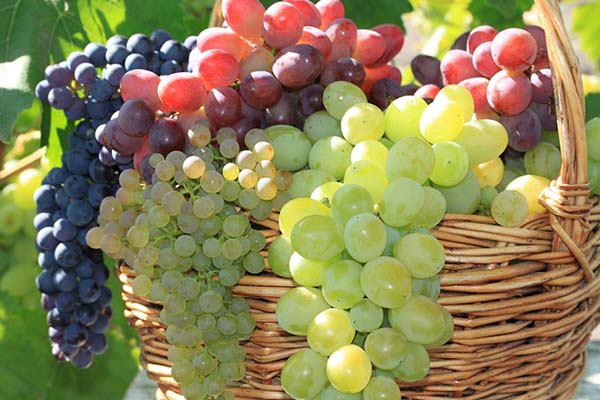
Content
Best table grape varieties: top 15
Note! The selection of the best grape varieties was compiled on the basis of an analysis and synthesis of various ratings, reviews, reviews of growers and characteristics (pros and cons of the variety), as well as the general interest of Internet participants (i.e. the popularity of the name of a particular variety).
Of the whole variety of table grape varieties, one can single out those varieties that are significantly superior in their properties to the rest. And on the basis of an analysis of their characteristics, advantages and disadvantages, you should choose the optimal varieties for your garden, based on your preferences, capabilities and characteristics of growing a particular variety.
Aleshenkin (Alyosha)
The variety was obtained by crossing Madeleine Angevin and a mixture of oriental pollen. Volgograd selection.
Medium and vigorous bushes.
Forms large clusters of loose structure, conical in shape, with an average weight of 350-500 g (maximum up to 2 kg).
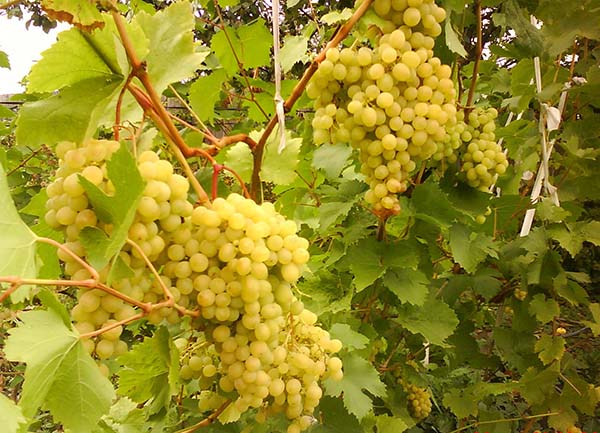
Has an amber hue with a white coating over the skin. Sufficiently small oval fruits, their weight reaches 3-5 g. The skin is thick. The pulp is crispy and juicy, with a pleasant sweet taste.
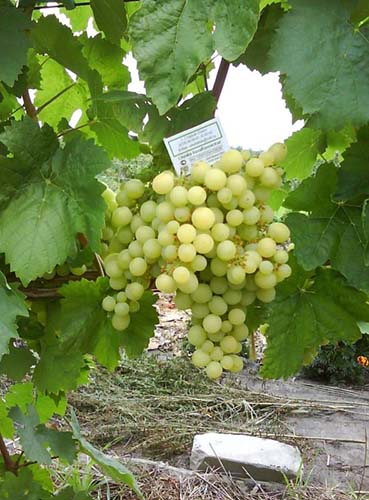
The main characteristics of the Aleshenkin variety:
- ripening period - 100-115 days (very early or very early);
- yield - 8-10 kg per bush.
- acidity - 3-6 g / l;
- sugar accumulation - up to 17-20%;
- eye load - 30-40;
- the recommended pruning is for 8-10 eyes (but you can also for a short one - 4-6 eyes).
- frost resistance up to -22 ..- 26 degrees.
Benefits:
- Very high tasting score (8.8 points).
- Consistently high yield.
- Amicable ripening of berries.
- Flowers are bisexual.
- High percentage of rooting cuttings.
Disadvantages:
- Susceptible to fungal diseases.
- Prone to peas.
- Ripening of the vine is satisfactory.
- It is prone to overload, therefore, it requires mandatory rationing (1 brush per 1 shoot).
Anyuta
A hybrid form of culture, obtained on the basis of Talisman (Kesha-1) and Radiant Kishmish. Amateur selection V.N. Krainova.
A variety of high vigor.
Anyuta forms large brushes weighing 700-800 grams (up to a maximum of 1.5 kg) of medium friability.

The fruit should be dark pink in color. Berries are oval, large, weighing 10-15 g (sometimes up to 20 g). The flesh is fleshy and the rind is firm. The variety is characterized by a subtle nutmeg aroma.
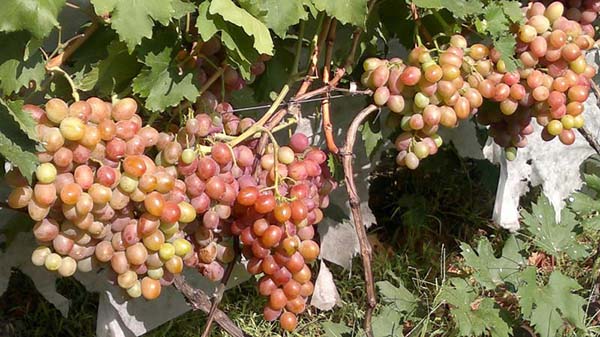
Characteristic features of Anyuta:
- ripening period - 140 days (medium or medium late);
- sugar accumulation - 18-50%;
- acid content - 5-7 g / l;
- fruiting rate - 1.3;
- eye load - 30-50;
- recommended pruning - 8-10 eyes;
- frost resistance up to -22 ..- 23 degrees.
Advantages:
- It has bisexual flowers, which gives stable pollination.
- The fruits do not crack even when the soil is waterlogged.
- Not prone to peas.
- Wasps are not damaged.
- Compatible with any rootstock.
- Good rooting of cuttings.
- Relative (average) resistance to mildew and oidium (3-3.5 points).
- Good vine maturation.
- Not damaged in transit.
Disadvantages:
- It is necessary to adjust the load, because prone to overload.
- There is often uneven ripening and color of the berry.
Arcadia
The variety was bred by crossing the Cardinal, which is responsible for the taste of the prototype, and Moldova, which has resistance genes. Selection IV&V them. V.E. Tairova (Ukraine).
By the way! Arcadia is also sometimes called Nastya.
Arcadia is distinguished by large dense bunches, with an average weight of 500-700 g (maximum - 2-2.5 kg). Their shape is cylindrical-conical, with blades.

Arcadia berries are characterized by an unobtrusive, simple, but pleasant taste, which, when ripe, acquires a light aroma of nutmeg. The color is uniform white, the size reaches 23 by 28 mm (egg-shaped), the weight is 7-10 g (maximum up to 15 g), depending on the care and agricultural technology (load of the bush). The pulp is dense with a juicy consistency, and the skin is strong, which makes it possible to transport with a minimum percentage of damage.
Characteristics of the Arcadia variety:
- ripening period - 115-125 days (early);
- sugar accumulation (sugar content) - 15-16%;
- acid level (acidity) - 4-6 g / l;
- fertility coefficient (number of clusters on a fruitful shoot) - 1.1-1.6;
- the ratio of fruitful shoots is 60-75%;
- yield - from 20 to 50 kg per bush;
- the load of the eyes on the bush during pruning is 30-50;
- pruning is recommended - for 8-12 eyes;
- frost resistance up to -21 ..- 23;
Note! Arcadia is distinguished by medium or fast growth of shoots and amicable ripening of fruits, which makes it possible to get the first full harvest already in the 3rd year of cultivation.
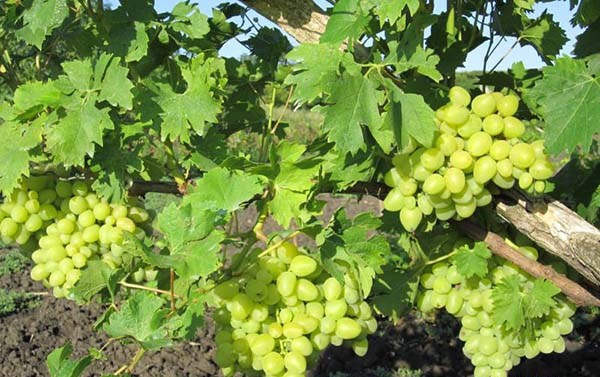
Advantages:
- Excellent tasting performance (8 points).
- Not bad resistance to mildew (3-3.5 points).
- Decent resistance to gray rot (2.5-3.5 points).
- Wasp is hardly damaged.
- No peas.
- High percentage of rooting cuttings.
- Compatible with many rootstocks.
- High transportability and marketability.
Minuses:
- Cracking during waterlogging of the soil.
- When overloaded with brushes, the ripening of the shoots worsens.
- Susceptible to powdery mildew.
Great
Obtained by crossing the varieties Bolgar and Alphonse Lavalle. Bred by Ivan Todorov (Bulgaria).
The growth of the bushes is very strong (transgressive effect), which often forces the plant to form even in the year of planting. The flower is bisexual.
The clusters are large (18 x 13 cm), with an average weight of 500-600 g, from conical to cylindro-conical, loose.
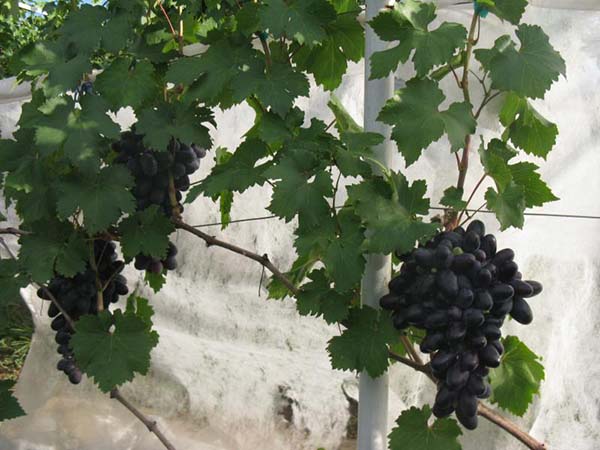
The berries are very large, with an average weight of 13-14 g (38.2x23 mm), elongated, slightly pointed towards the top, color from dark red to dark purple. The skin is thick, firm, and edible. The pulp is crispy, the taste is harmonious, reminiscent of the Bolgar variety. Seeds are medium in size, round pear-shaped, with a short beak, dark brown.

Characteristics of the Velika variety:
- ripening period - 130-140 days (average);
- yield - 9.8 kg per bush, 350 kg / ha;
- sugar content - 15-17%;
- acidity - 5 g / l;
- pruning fruit vine - 5-7 eyes;
- frost resistance up to -22 degrees.
The recommended type of shaping is a two-plane trellis.
Benefits:
- The berries do not crack.
- Wasps are not affected.
- The vine ripens perfectly.
- Disease resistance is average.
- Highly transportable.
- Stores relatively well in the refrigerator.
Has a good affinity with rootstocks CO4, 41B, Monticola. But rootstocks are recommended that inhibit the strong growth of the scion: Chassela x Berlandieri 41B, CO4, etc.
Disadvantages:
- In the north, it is highly susceptible to fungal diseases, primarily mildew.
Victor
Bred by amateur winegrower V.N.Krainov (Transfiguration and Jubilee of Novocherkassk are also his varieties).
The variety is medium or vigorous.
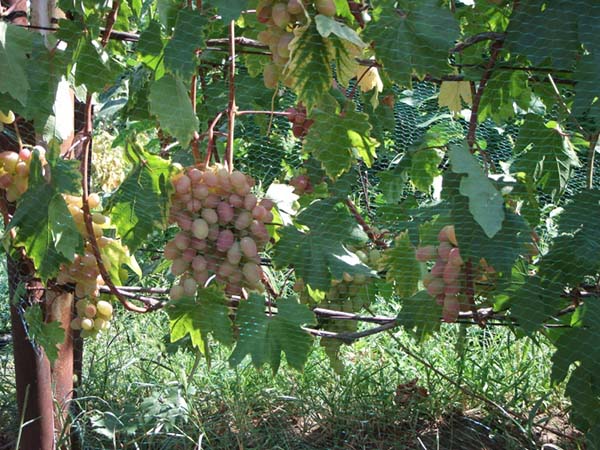
Grape clusters are large (up to 2 kg) or medium in size, weighing 500-1000 grams, medium density.
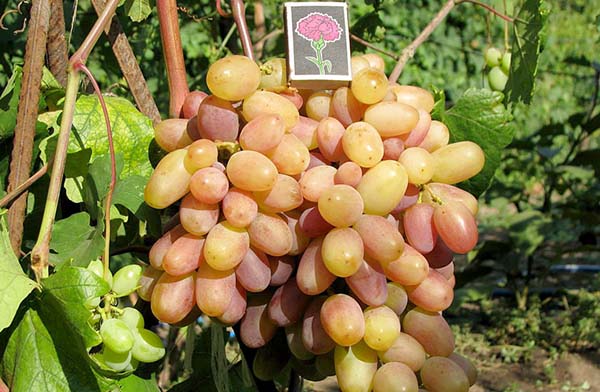
The color changes as the fruit ripens from pink-amber to red-lilac. Fruits in the form of an elongated oval with a pointed end. Very large, their weight is about 9-15 g (maximum up to 20 grams), and their length is about 50 mm. The taste is pleasant, the pulp is fleshy and juicy, with an average density. Victor has a thin edible rind.
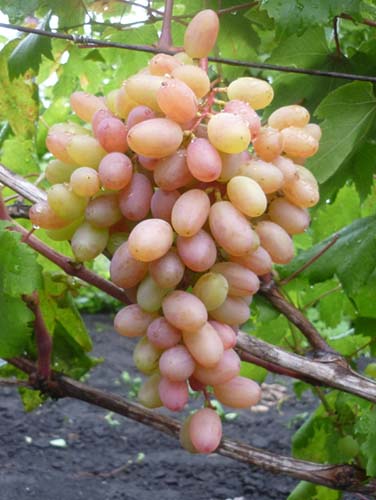
Characteristics of the Victor variety:
- ripening period - 100-110 days (very early or very early);
- sugar content - up to 17 g / l;
- acid content - 8 g / l;
- the maximum load of the eyes is 30-40;
- trimmed into 8-10 eyes;
- frost resistance up to -23 degrees.
Advantages:
- Bisexual flowers.
- Yield stability.
- Not prone to peas.
- Shoots ripen well.
- Excellent presentation.
- Good resistance to common fungal diseases (mildew, powdery mildew, gray mold).
By the way! Victor forms many stepchildren, which makes it possible to re-harvest on new shoots.
Disadvantages:
- Very early flowering period, which increases the likelihood of damage to inflorescences in the event of late spring frosts.
- Attractive to wasps.
- It is necessary to graft on vigorous rootstocks.
By the way! You can read about other pink grape varieties here.
Delight White (Delight)
This variety is obtained by combining the qualities of Zori Severa and Dolores, as well as Russian early. Breeding VNIIViV them. Ya.I. Potapenko (Russia).
Bushes are medium to vigorous.
By the way! It has established itself well as an arched culture, i.e. can be grown on gazebos.
The bunches can be shapeless, or they can take the shape of a cone, their weight varies within 600-800 g (maximum up to 2 kg), depending on the cultivation technique.
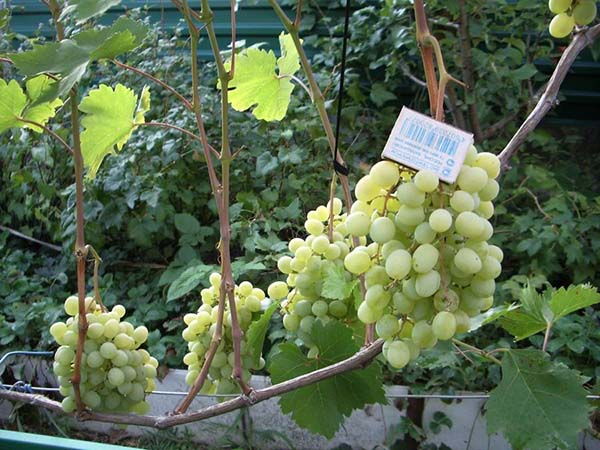
The fruits have a soft creamy shade with a slight blush on the skin on the sunny side. The fruits are large, their weight is 5-8 g. The taste is harmonious. It has a crispy, dense pulp with a thin skin, which is almost imperceptible when consumed (eaten).
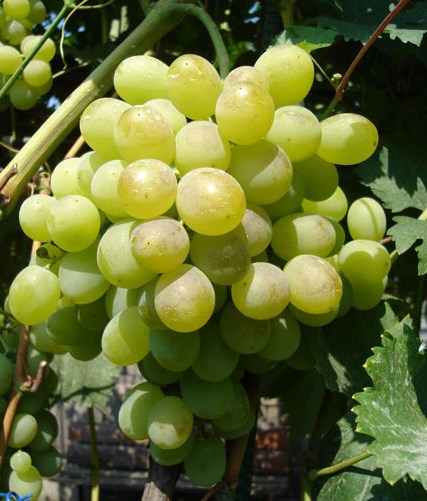
The main characteristics of the White Delight variety:
- ripening period - 110-120 days (very early or early);
- sugar ratio - 19-26%;
- acid content - 5-9 g / l;
- the rate of fruitful shoots is 65-85%;
- the number of clusters per shoot - 1.4-1.7;
- the optimal load of the eyes is 35-45;
- trimming can be 6-10 eyes (but you can also trim 2-4);
- frost resistance up to -25 degrees.
Advantages:
- The tasting indicator is 8.6 points.
- Differs in bisexual flowers.
- Relative resistance to mildew (3-3.5 points) and high - to gray rot (2 points).
- Very good maturation of the vine.
- It can hang on the vine for a very long time and not deteriorate (up to 1-1.5 months).
- The cuttings take root quickly.
- Wasps are not damaged.
- Does not lose its commercial qualities during transportation.
Minuses:
- May be sick with powdery mildew.
- Susceptible to phylloxera.
- Needs vigorous rootstocks.
Kesha White (Delight Superior)
The variety was bred by crossing the variety Vostorg and Frumoasa Albé. Breeding VNIIViV them. ME AND. Potapenko (Russia).
Bushes are vigorous.
The clusters are cylindrical-conical or conical, often shapeless, of medium density. The average weight is 600-900 g.

The berries are of a uniform amber-white color. The fruits are very large, oval, length up to 32 mm, width up to 24 mm, average weight 10-12 g, some up to 20 grams. Kesha is characterized by a dense texture with a pleasant taste. Seeds per fruit - 1-3.
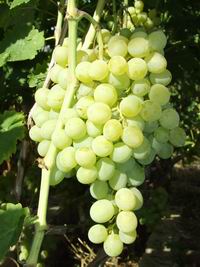
Characteristics of the Kesha variety (Improved Delight):
- ripening period - 120-130 days (early or early middle);
- sugar accumulation - 19-24%;
- the amount of acids is 5-8 g / l;
- the ratio of fruitful shoots is 65-80%;
- the number of bunches - 1.2-1.6;
- eye load - 35-40;
- needs to be trimmed for 8-12 eyes.
Advice! Kesha will bear fruit better on strong formations with a large supply of perennial wood.
- frost resistance up to -23 degrees.
Benefits:
- Tasting qualities (8.0 points).
- Has flowers of both sexes.
- Highly resistant to mildew.
- Shoots ripen well.
- High percentage of rooting cuttings.
- Never peas.
- It can hang without losing its taste until the very frost.
- High transportability.
Disadvantages:
- With a strong load on the brushes, the berries become smaller.
- He does not like frequent temperature changes and icing of the vines, because of this, the buds are vomited.
Important! Do not over-feed with nitrogen fertilizers.
Codryanka
The variety was bred by crossing the varieties of Moldova and Marshal. Breeding "Vierul" (Moldova).
It is characterized as a vigorous plant.
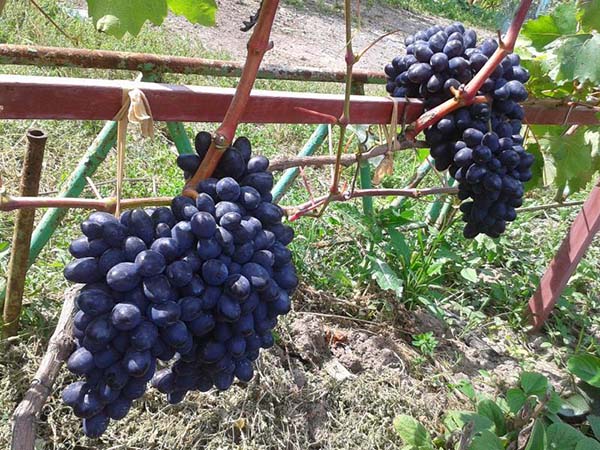
Grape clusters weigh on average 400-600 g, but there are also some up to 1200-1500 g. The structure is medium-soft (moderately dense).
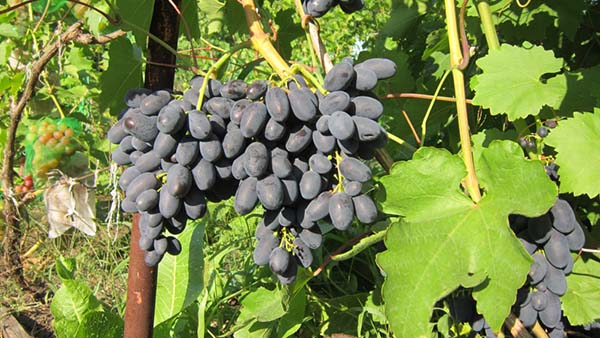
The berries are dark purple in color. Fruit weight - 6-8 g, shape - oval, average length - 31 mm, width - 19 mm. The taste is simple, but the flesh is crunchy, the easily separated bones and imperceptible rind, when used together, give a good tasting quality.
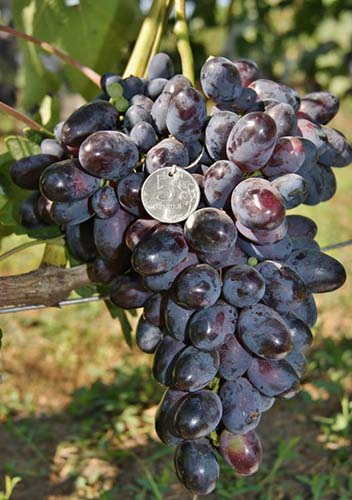
Characteristics of the Codryanka variety:
- ripening period - 110-120 days (very early or early);
- sugar accumulation - 18-19%;
- the ratio of acids is 6-7 g / l;
- fruitful shoots - 70-85%;
- the number of clusters per fruitful shoot - 1.2-1.7;
- load on the bush during pruning - 40-50 eyes;
- trimming - for 8-10 eyes;
- frost resistance up to -22 - .. 24 degrees.
Note! Codryanka can be consumed even with incomplete accumulation of sugar in berries (12-14%), since this variety is characterized by a rapid decrease in acidity.
The advantages of the variety:
- Tasting score (8.2 points).
- Has increased resistance to gray rot, as well as to mildew and powdery mildew (3 points).
- Tolerant to phylloxera (grape aphid).
- Good maturation of shoots.
- It can hang on bushes for a long time without loss of taste.
- Excellent marketability and transportability.
- Weakly affected by wasps.
- Good keeping quality - suitable for short-term storage.
By the way! Responds well to gibberellin treatment.
Disadvantages:
- Possibly peas.
Important! It is rightfully one of the best, most popular and problem-free grape varieties.
Libya
The hybrid was bred by crossing based on the main qualities of the Flamingo and Arcadia varieties. Breeding "Magarach" (Ukraine), V.V. Zagorulko.
Forms vigorous plants.
The bunches of Libya are large, 25 cm or more long, cylindrical, moderately loose.

It has an uneven color - from light pink to saturated when the bunch ripens. The size of the berries is 28 mm by 18-20 mm (oval or ovoid), weight is 10-15 grams. The pulp is fleshy and juicy, the rind is not felt during use. Each berry contains no more than 1-3 seeds, which are easily separated. Libya is characterized by a pleasant taste with a nutmeg hue. The aroma lasts for 30 days during storage.

Characteristics of the variety Libya:
- ripening period - 105-110 days (very early);
- sugar accumulation - 20-25%;
- acidity - 6-7 g / l;
- the ratio of fruiting shoots is 70-80%.
- pruning shoots is recommended for 2-6 eyes.
- frost resistance up to -21 degrees.
Benefits:
- Stable yield.
- The flowers on the plant are bisexual, which guarantees a stable ovary.
- Shoots ripen perfectly.
- Excellent transportability.
- Good marketability.
Important! Saplings grow better on their own roots than on a scion.
Minuses:
- Very average resistance to powdery mildew (3.5-4 points).
- Uneven color of berries.
- Poor vine ripening at the slightest overload.
Laura (Flora)
The species was obtained by crossing a mixture of pollen from Muscat Hamburg and Husayne, Muscat de Saint-Vellier, Queen Tairovskaya and a mixture of pollen from Central Asian varieties. Selection IV&V them. V.E. Tairova (Ukraine).
Laura is a medium to vigorous shrub that does not pick up very well. When pinching, it is imperative to leave 1-2 leaves, otherwise the buds intended for growth next year will start to grow.
Forms conical clusters of predominantly loose structure weighing up to 1 kg (on average 600-800 grams).
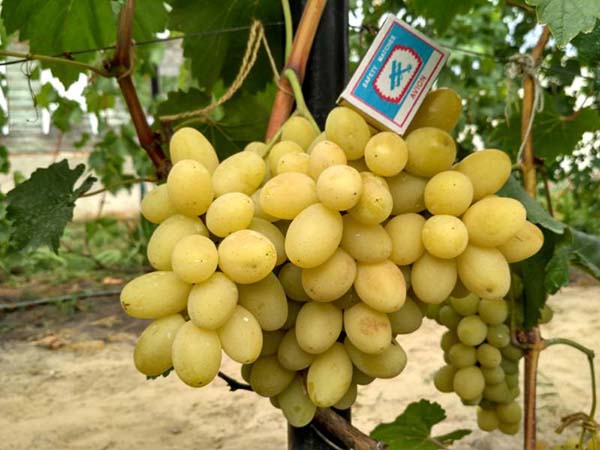
The color is light green with white prune; in the sun, the fruits acquire a light tan. The berries are either cylindrical or oval, sizes - 30 by 22 mm, weight - 6-10 g. The flesh is crispy, the seeds are large. The rind is firm but thin. The fruits are firmly attached to the stalk, so the bunches do not crumble. The taste of the grapes is unobtrusively pleasant (accentedly oriental).

Characteristics of the variety Laura (Flora):
- ripening period - 110-115 days (very early);
- sugar accumulation - about 20% or more (up to 23%);
- acidity - 5-8 g / l;
- the number of fruitful shoots - 60-80%;
- the number of bunches per fruitful shoot - 1.3-1.5;
- eye load - 40-50;
- vines can be cut medium by 5-6 eyes or short by 2-4.
Note! The variety is not picky about care and is flexible to climatic conditions.
Benefits:
- High tasting score (8.9 points).
- Flowers are predominantly female, but pollinated well and the ovary occurs evenly.
- Good vine maturation.
- Cracking of the fruit is extremely rare.
- Relative resistance to mildew (3 points).
- Not affected by gray mold.
- High resistance to phylloxera.
- Not peas.
- Can hang on bushes for a long time and accumulate sugar.
- Not damaged during transportation.
- Excellent marketable berry.
Advice! The use of gibberellin lengthens the berries and produces seedless grapes.
Minuses:
- Sometimes it is affected by powdery mildew.
- Berries, due to the high percentage of sugar, are often damaged by wasps.
By the way! If you use vigorous rootstocks, you can achieve larger berries, but the ripening period will slightly increase and sugar accumulation will decrease.
Moldova
The variety is obtained by crossing Villard Blanc and Guzal Kara. Breeding "Vierul" (Moldova).
Bushes are vigorous.
Suitable as a gazebo culture.
The leaves are rounded, five-lobed, poorly dissected. There is an edge on the reverse side of the leaf plates.
The clusters are cylindrical-conical, with an average level of density. The mass of the bunch is within 400-600 g, but some are up to 1 kg.
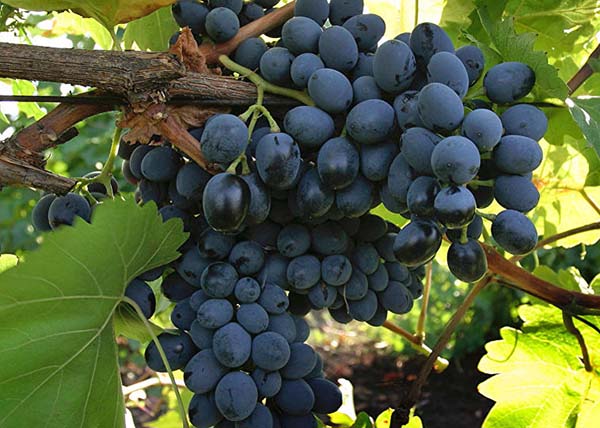
The fruits have an inky (dark purple) shade with a thick waxy coating. Berries are oval, 25 x 19 mm in size, weighing 5-6 grams. The pulp is dense, crispy, firm, and therefore felt when eaten. The taste is simple.
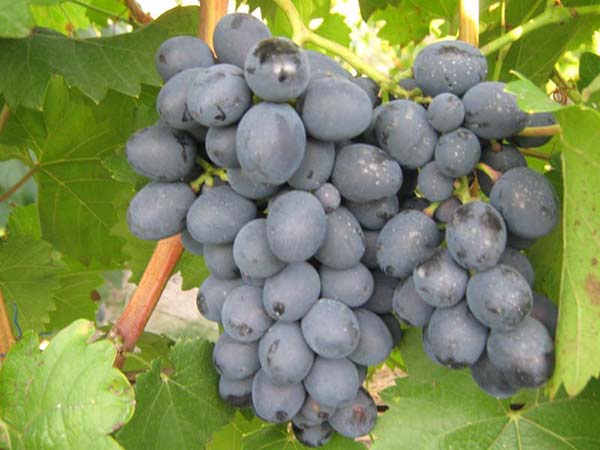
Characteristics of the Moldova variety:
- ripening period - 155-165 days (late);
- sugar accumulation -17-19%;
- acid content - 7-10 g / l;
- the ratio of fruitful shoots is 70-80%;
- the number of bunches - 1.4-1.8;
- load on the bush - 50-65 eyes;
- recommended pruning for 6-8 eyes;
- frost resistance up to -23 degrees.
Note! Moldova is not demanding on agricultural technology, but at the same time it has a high yield stability. However, when the plantings thicken, the yield and quality of the fruits sharply decrease.
Benefits:
- Excellent tasting score (9.5 points).
- Differs in bisexual flowers.
- Begins to bear fruit early.
- Shoots ripen well.
- Resistant to mildew, gray mold, powdery mildew and phylloxera.
- Wasps are not damaged.
- Almost never peas.
- The berry does not crack under any circumstances.
- Stores well on bushes.
- High commercial quality.
- Well transported and stored.
Disadvantages:
- Susceptible to calcareous chlorosis.
- Susceptible to Phomopsis.
Nadezhda AZOS
Obtained by crossing Moldova and Cardinal varieties. Selection AZOS (Russia).
The growth force is great. The flower is bisexual.
The bunch is large and very large, weighing 600-900 g and larger. Medium density or loose, conical or branched.
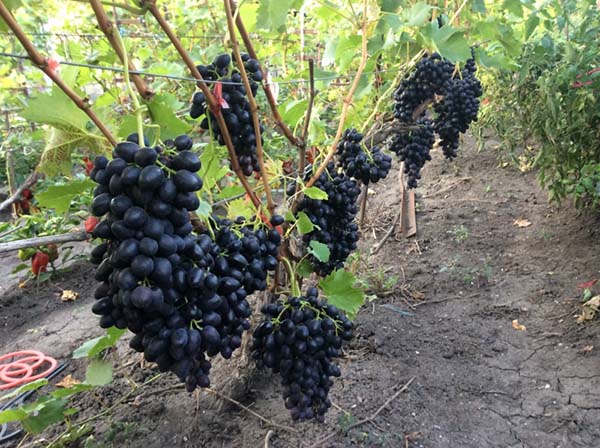
The berry is dark blue (purple), oval (29 x 23 mm), weighing 5-8 g or more. The pulp is firm and fleshy, crispy. The taste is simple but very harmonious.
Characteristics of the variety Nadezhda AZOS:
- ripening period - 120-130 days (early middle);
- sugar content - 15-17%;
- acidity - 7-8 g / l;
- fruitful shoots - 80-90%;
- the number of bunches per fruitful shoot - 1.2-1.6;
- load on the bush during pruning - 35-45 eyes;
- pruning fruit vines - for 8-10 eyes;
- frost resistance up to -22 ..- 23 degrees.
Advantages:
- Good resistance to fungal diseases (2.5-3.5 points): resistant to mildew, gray mold, increased resistance to powdery mildew.
- Ripening of shoots is good.
- Wasps are not damaged.
- It has high indicators of marketability and transportability.
- It can hang on the bush until frost, while not losing its taste.
Disadvantages:
- The cuttings are poorly rooted.
- It is prone to overloading the bush, while the clusters become smaller, normalization of the inflorescences and bunches is required.
Transformation
A hybrid of grapes obtained as a result of amateur selection by V. Krainov.
Vigorous plants with a high degree of formation of stepsons.
Forms mainly shapeless and conical clusters weighing 700-1500 grams.
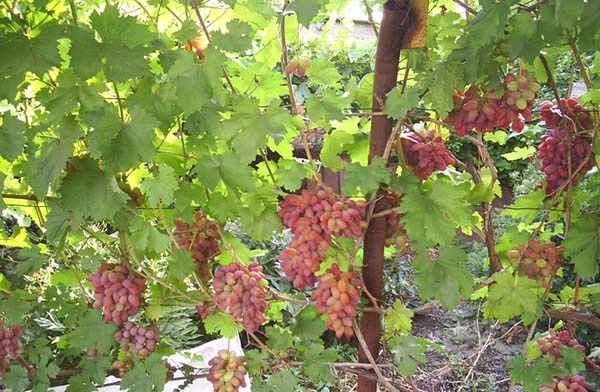
The color of the berries is from intense pink to red, more often the color is amber-pink, of an uneven color. Fruits are large, oval-elongated, weight reaches 10-14 g. Taste qualities are harmonious. The flesh of the Transfiguration is fleshy, the skin is medium-dense, but not perceptible when consumed.

Characteristics of the Transfiguration variety:
- ripening period - 105-110 days (very early);
- sugar content - 17-19%;
- acid ratio - 6-7 g / l;
- the load of the bush with shoots - up to 30-35;
- optimal pruning by 6-8 eyes, but a good result is also obtained by pruning by 2-4 eyes;
- frost resistance up to -23 degrees.
Benefits:
- Has bisexual flowers.
- Good resistance to gray mold.
- Very high transportability and marketability.
- There is a possibility of re-harvesting on stepchildren.
- No peas.
- Good maturation of the vine.
Disadvantages:
- Very average resistance to common fungal diseases: mildew and oidium (3.5-4 points).
- Attracts wasps.
- Load rationing is required.
Important! Does not tolerate close proximity to trees and shrubs.
Rochefort
A hybrid form of amateur selection, by a complex crossing of the Talisman variety and the Cardinal variety with a mixture of pollen.
Great strength of growth. With a bisexual flower.
The bunches are medium, loose, weighing 300-400 g (individual 1 kg).

The berries are dark blue, rounded, 21.5 by 20.5 mm, with an average weight of 6-7 g (some up to 13-17 grams), Good harmonious taste, the skin is eaten, the flesh is fleshy.
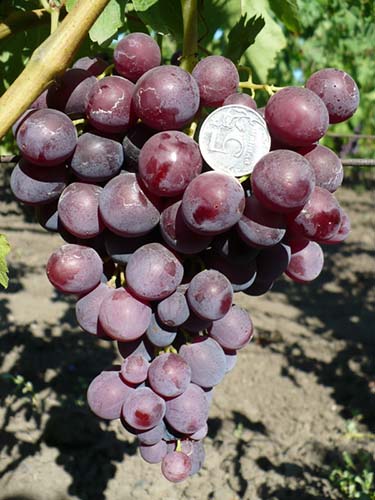
Rochefort characteristics:
- ripening period - 95-110 days (very early);
- sugar content of berry juice - 14.8 g / 100 cm3;
- acidity 5.6 g / dm3;
- frost resistance up to -15 ..- 18 degrees.
Advantages:
- Ripening of shoots is good.
- The berries can hang on the bush for a long time without cracking.
- The variety is not damaged by wasps.
- Has good resistance to mildew and gray mold.
Disadvantages:
- It is affected by powdery mildew.
Taifi pink (Taifi kizyl, Toipi kizyl, Toifi antimony, Gissori)
Belongs to the group of oriental (Asian) grape varieties.
Bushes are vigorous. The flower is bisexual.
The bunch is large or very large (27 cm long, 19 cm wide), conical or cylindro-conical, with very developed lateral lobes, loose. The stem of the cluster is of medium length or long (3-7 cm), lignified at the base. The average weight of a bunch is 675 g, the maximum (in Uzbekistan) is 6.5 kg.
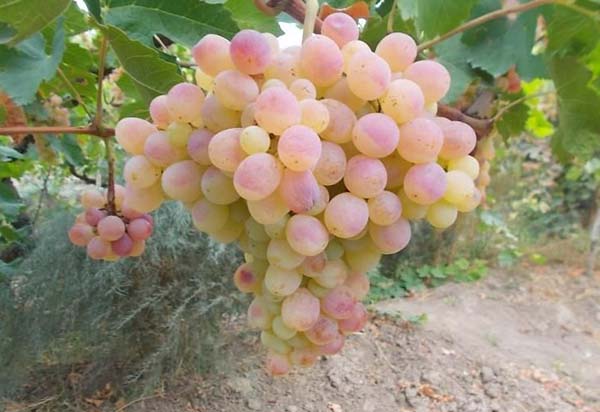 When fully ripe, berries are dark pink with a purple tint (initially yellow with purple spots), covered with a medium waxy bloom and dots. The berry is very large (27 mm long, 19 mm wide), oblong-oval or cylindrical, with a beveled top. Sometimes there is a shallow groove at the top of the grape. The average weight of berries is 4-8 g. The skin is thick, bright red on the inside. The pulp is dense, fleshy-crunchy, pleasant taste. The juice is colorless. The berry contains 2-3 medium-sized seeds.
When fully ripe, berries are dark pink with a purple tint (initially yellow with purple spots), covered with a medium waxy bloom and dots. The berry is very large (27 mm long, 19 mm wide), oblong-oval or cylindrical, with a beveled top. Sometimes there is a shallow groove at the top of the grape. The average weight of berries is 4-8 g. The skin is thick, bright red on the inside. The pulp is dense, fleshy-crunchy, pleasant taste. The juice is colorless. The berry contains 2-3 medium-sized seeds.
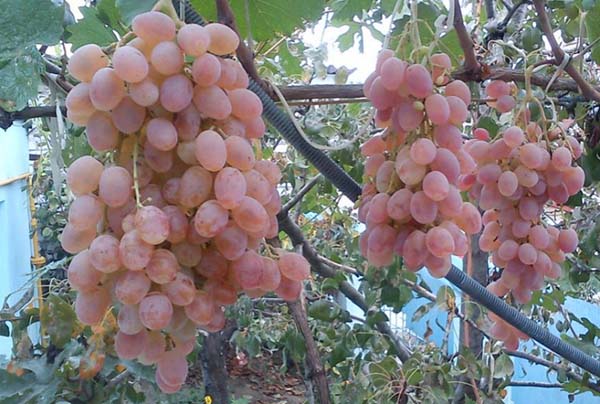
Characteristics of the Taifi pink variety:
- ripening period - 167 days (late);
- sugar content - 17.2 g / 100 ml;
- acidity - 6.5 g / l;
- the percentage of fruitful shoots - 25.6%;
- the average number of clusters on a developed shoot is 0.1, on a fruitful one - 0.7.
- frost resistance up to -15 ..- 18 degrees.
The grape variety requires formation on a high stem with a large supply of perennial wood, long pruning of shoots.
Advantages:
- Good tasting score (7.4 points), and high in Central Asia (9 points).
- It is relatively salt-tolerant and drought-tolerant.
- Hangs on the bush for a long time without problems.
- Pulls a heavy load.
- Well stored and transported.
Disadvantages:
- Weakly resistant to mildew and oidium.
- It is damaged by a spider mite.
- Not very hardy.
Of course, the rating should include such a variety as Somerset Siddles, but, unfortunately, it is not so popular, which means that it will be quite difficult to get seedlings or cuttings, especially to buy ready-made grapes in a store. But, for example, Radiant kishmish, Rizamat and Talisman (Kesha-1) well-known varieties, but still not like those listed above.
Important! Information about other excellent (but less popular) table grape varieties you can find in this material.
The best wine grape varieties: top 5
Technical grape varieties are distinguished by a high content of juice in fruits, as well as a low ratio of the mass of the comb in relation to the mass of fruits. Therefore, these varieties are ideal for making juices, compotes, marinades and, of course, wines. Indicators of marketability and beauty of the bunch in this case recede into the background. In addition, wine varieties do not require special cultivation techniques, they grow well and bear fruit without additional fertilizing, they do not need to be covered for the winter and shaped (cut off).
August
The variety was bred on the basis of Kazachka and SV 12-309. Breeding VNIIViV them. ME AND. Potapenko (Russia).
Forms vigorous bushes.
Augustus has small (110-120 g) brushes of conical shape, dense and medium loose structure.
The berries are dark blue with a prune bloom. Round small fruits weigh 1.3-1.7 g. Taste qualities of the variety are harmonious with an unobtrusive note of nutmeg. The pulp of the fruit is juicy, fleshy, with a dense skin, the juice is not colored.

Characteristics of the Augusta variety:
- ripening period - 128-130 days;
- sugar content - 23-24%;
- acidity - 9 g / l;
- fruiting coefficient - 1.6;
- yield - 100-110 c / ha (with a planting scheme of 3 by 1.5 meters);
- optimal load - 20-25 eyes;
- permissible trimming - 3-4 eyes;
- winter hardiness up to -24 ... -25 degrees.
This grape is used for dry and dessert wines.
Advantages:
- Not a bad dry wine tasting score (7.5 points).
- High resistance to powdery mildew (1.5 points), good to mildew (2.5 points), medium to phylloxera (3.5 points).
- High rate of rooting of cuttings.
- Compatible with different stocks, but Kober 5BB or 101-14 is better.
Disadvantages:
- Very much stepson (chases stepsons just with terrible force).
He loves watering very much, in this case the clusters will be bigger, but without watering it grows very average.
Alpha
Bred in the USA by crossing V.labrusca x V.riparia.
The variety is characterized by medium and vigorous bushes.
Differs in large sharp-toothed three-lobed leaves with an average degree of dissection.
Forms medium-sized cylindrical or cylindrical-conical brushes with a dense to medium loose structure. The average weight of a bunch is 120 g, the maximum is 220 g.
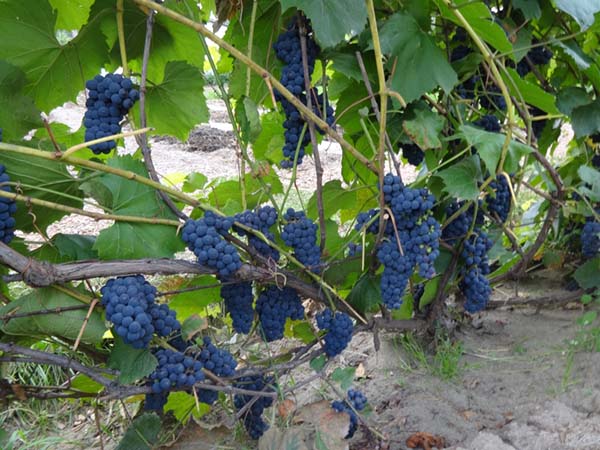
The color of the berries is black with a reddish-purple tint; they are also covered with a thick waxy bloom. The fruits are round and medium in size. The skin is dense, firm, easily separated from the pulp. The mucous flesh of the berries has a pronounced very sharp sour taste, with a well-pronounced strawberry aroma, it is poorly separated from the seeds.
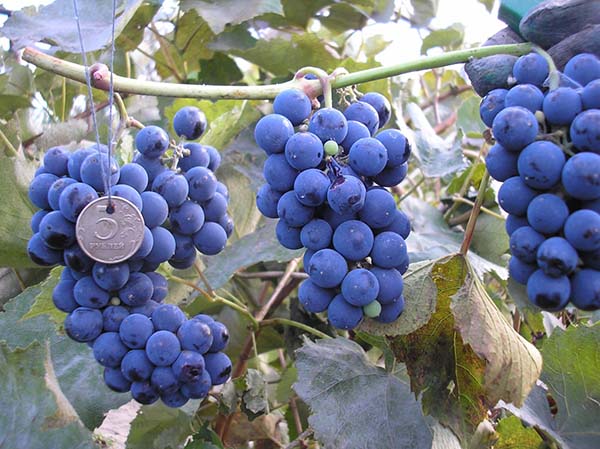
By the way! Alpha is great for landscaping gazebos, balconies and walls.
Characteristics of the Alpha variety:
- ripening period - 140-145 days;
- yield 150-180 c / ha;
- sugar content - 15-16%;
- acidity - 10-11 g / l.
Advantages:
- It is characterized by bisexual flowers, so pollination does not cause any difficulties.
- Weakly susceptible to diseases: relatively resistant to mildew, anthracnose.
- The ripening of the vine is very good.
- Perfect as a rootstock for varieties with low frost resistance.
Disadvantages:
- It is affected by spots and pests.
- Has a very high acidity level.
Crystal
The variety was created on the basis of a complex crossing of Amur and Challozi Lajos with Villard Blanc. Hungarian selection.
Variety with medium vigor.
Leaves are dark green in color, strongly cut.
The brushes are medium, of moderate density, their weight varies within 170-220 g.
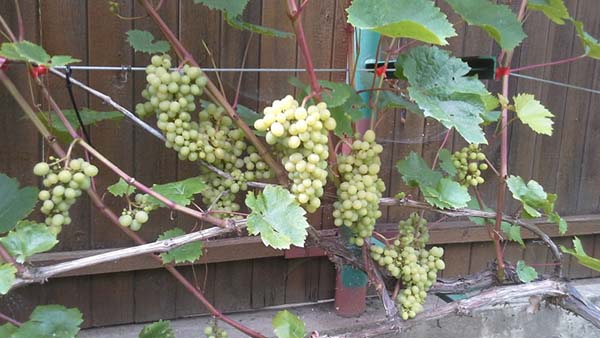
The fruits are yellow-green or white with a prune bloom. Medium size, oval, each weighing from 1.5 to 2.1 g. The pulp is juicy, the peel is strong. The taste is harmonious.

Dry wines of the sherry type are produced from Kristall.
Characteristics of the Crystal variety:
- ripening period - 110-115 days;
- sugar accumulation - 17-18%;
- acid content - 6-7 g / l;
- the ratio of fruitful shoots - 85-90%;
- the ratio of bunches per shoot is 1.3;
- optimal load - 60 eyes;
- recommended pruning of vines - 3-4 eyes;
- frost resistance up to -29 degrees.
Important! This variety does not tolerate thickening of plantations, which threatens with shedding of the ovary, disheveled brushes and loss of yield.
Benefits:
- Excellent ripening of a one-year vine - 90-100%.
- Ripe brushes remain on the shoots for a long time (until frost).
- Not affected by gray mold.
- High resistance to powdery mildew - 2.5 points, to mildew - 2 points.
Disadvantages:
- With a low level of sugar accumulation, the acidity decreases to 3.5-4 g / l, which significantly worsens the quality of the wine.
Muscat
There are a lot of wine muscats, these are Muscat Blau, Muscat Don, Muscat Golodrygi, but Odessa Muscat and Pink Muscat are especially distinguished.
Odessa Muscat
The variety was bred by crossing the early blue Muscat and Pierrelle. Selection IV&V them. V.E. Tairova (Ukraine).
Growth strength is above average.
Odessa Muscat is distinguished by tassels of 130-190 g, cylindrical conical shape. Their density is average, often with one wing.
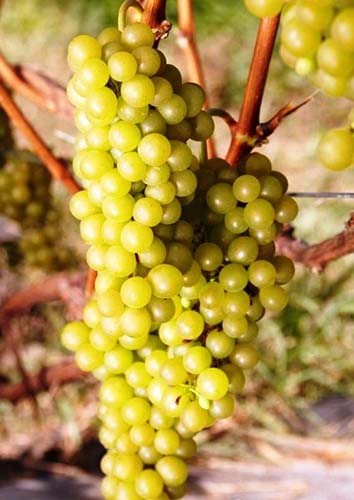
The color of the berry is yellowish green. Fruits are round, measuring 14.2 x 13 mm and weighing about 2 grams. The taste is harmonious with a rich nutmeg aroma. The pulp is slimy, the skin is dense, but thin.
It is used for the preparation of white table and dessert wines, sparkling nutmeg and juices.
Characteristics of the variety Muscat Odessa:
- ripening period - 130-140 days;
- sugar content - 18.6-22%;
- acidity - 5.5-8.7 g / l;
- the ratio of fruitful shoots is 80-87%;
- the number of bunches - 1.2;
- optimal load - 30-35 eyes;
- pruning vines - 3-4 eyes;
- frost resistance up to -24 degrees.
Advantages:
- Highly resistant to mildew (2.5 points) and oidium (2 points).
- Good maturation of shoots.
Pink Muscat (Red Muscat, Muscat Rouge de Fronttignan, Moscato Rosso di Madera)
It is a variation of White Muscat. Pure wine variety.
Bushes of medium vigor. The flower is bisexual.
A cluster of medium size (14-18 cm long, 7-10 cm wide), cylindrical or cylindrical-conical, dense. The mass of the bunch is 108-204 g.

The berry is dark red, covered with a thick waxy coating, small or medium-sized (11-18 mm long, 10-17 mm wide), round. The skin is thin but firm. The pulp is juicy, tender, with a strong nutmeg aroma. There are 2-4 seeds in a berry.
It is used for the preparation of vintage liqueur Muscat wines: South Coast Pink Muscat, Dessert Pink Muscat, Magarach Pink Muscat, which have an original aroma with hints of Kazanlik rose, as well as sparkling wine materials and table wines.
Characteristics of the Muscat pink variety:
- ripening period - 140 days (average);
- yield - 60-80.3 c / ha;
- sugar accumulation - 17.9-24.2 g / 100 ml;
- acidity - 4.8-9.1 g / l;
- frost resistance up to -15-18 degrees.
Advantages:
- Ripening of annual shoots is good or satisfactory.
Pink Muscat is less whimsical to soil and climatic conditions than White Muscat. Better adapted to various soil moisture conditions.
Disadvantages:
- Average yield.
- The grape variety is not resistant to mildew, strongly affected by powdery mildew.
- It is damaged by phylloxera and grape leafworm.
- It often cracks and decays.
- Differs in very low frost resistance.
Platovsky
The variety is obtained by crossing on the basis of the qualities of the Gift of Magarach and Zalandede. Breeding VNIIViV them. ME AND. Potapenko (Russia).
Bushes with medium vigor.
Platovsky is characterized by a cylindro-conical shape of clusters of moderately dense structure, the mass of which reaches 200 g.

White-pink color. The fruits have a juicy pulp with a thin but dense skin. Weight of 1 berry is 2-3 g. Taste properties of the variety are harmonious.
Characteristics of the Platovsky variety:
- ripening period - 110-115 days (early);
- sugar accumulation - 20%;
- acidity - 9 g / l;
- fruitful shoots - 85%;
- bunch ratio - 1.3;
- optimal load - 60-80 eyes;
- recommended pruning of vines - 3-4 eyes;
- frost resistance up to -29 degrees.
Important! To accelerate the ripening process of fruits, Platovsky needs the timely removal of the foliage covering the bunches.
Advantages:
- High tasting index of dry table wine (8.4 points)
- Good ripening of shoots (about 80%).
- High resistance to mildew (2 points), gray rot (2 points), powdery mildew (2.5 points), average - tophylloxera (3 points).
- The harvest lasts 30 days on the bush without losing its qualities.
Disadvantages:
- Mandatory removal of stepchildren, sterile and underdeveloped shoots is required.
- It picks up old wood poorly.
- Needs rationing (no more than 2 bunches per shoot).
- Needs a special rootstock - Kober 555.
Of course, there are no less wine grape varieties than table ones. But we must admit that they do not have such fame, because they are almost not grown in summer cottages, but only in special vineyards (on an industrial scale). So many varieties are also often used to make wine.Magarach, Cabernet and others (see below).
Note! Familiarize with other excellent (but lesser known) technical grape varieties you can by reading this article.
The best universal grape varieties: top 5
Of course, what such grape varieties are especially good for is their versatility, because the berries can be consumed both fresh and used for processing into wine or juice. In addition, they are quite unpretentious to care for and tolerate frost better (but not all of them should still be covered).
It is worth understanding! From universal varieties, most often, they still make various drinks, although their berries are quite edible (unlike wine ones), they can hardly compete with table varieties.
Gurzuf pink
Obtained by crossing varieties Muscat VIRa and Magarach 124-66-26. Selections of illegal armed group "Ampelos" (Ukraine).
Vigorous bushes with bisexual flowers.
The clusters at Gurzufsky are cylindrical or cylindrical-conical, winged, medium or large in size, loose, with an average weight of about 250 g.
By the way! The taste is very reminiscent of the Hamburg Muscat variety.
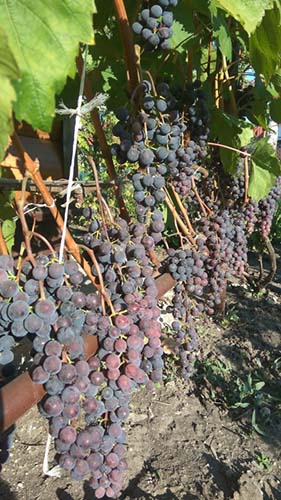
The berries are dark red. The fruits are round in shape, differ in fleshy pulp. The peel of the fruit is dense. The palate is pleasant and harmonious, with a pronounced nutmeg aroma. The number of seeds in fruits is from 3 to 4 pieces.
Recommended for making high quality pink dessert wines.
Characteristics of the Gurzuf pink variety:
- ripening period - (110-115 days) early;
- yield - 150 g / ha;
- sugar accumulation - 25-29%;
- acidity - 6-7 g / l;
- optimal load - up to 40 eyes;
- recommended pruning of vines - 2-4 eyes;
- frost resistance up to -25 degrees.
Advantages:
- Good tasting score (7.9-8.0 points).
- Field resistance to common diseases (mildew, oidium, gray mold).
- Good maturation of the young vine.
Minuses:
- Relatively weak resistance to phylloxera.
- The overall taste is spoiled by a thick rind that remains in the mouth with a herbaceous taste.
Zilga
Bred on the basis of a complex crossing of the Smuglyanka variety with a mixture of pollen from Dvietes zila and Yubileiny Novgorod. Selections P. Sukatniek (Latvia).
Bushes are vigorous.
Note! The variety is great for gardening gazebos.
Brushes are cylindrical, large, weighing 320-400 g, often with a wing, generally have a dense structure, but sometimes they are loose.

It has a uniform dark blue color. Oval fruits are large in size, weighing 4.1-4.3 grams. The flesh is slightly slimy, with a slight isable aroma.
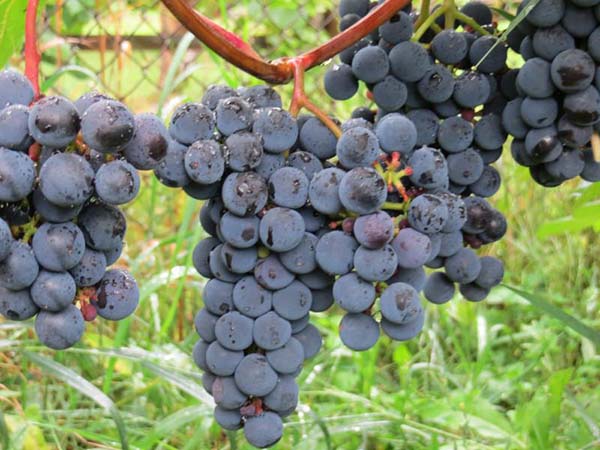
Characteristics of the Zilga variety:
- ripening period - 102-108 days;
- sugar accumulation - 18-22%;
- acidity - 4.5-5 g / l;
- the ratio of bunches is 1.5-1.9;
- shoots ratio - 80-85%;
- load - 30-40 eyes;
- optimal pruning of vines - 3-4 eyes;
- frost resistance up to -25 degrees.
Advantages:
- The crop is preserved for a long time on the bush without loss of quality.
- Resistant to major diseases (mildew, oidium and gray rot).
- Shoots ripen very well.
- Not damaged in transit.
- Compatible with different rootstocks.
Disadvantages:
- Average tasting assessment of the quality of fresh fruits (7.1 points).
Note! Although in one of the popular ratings (site www.expertcen.ru) this grape variety has a very high score - 9.6 points.
Isabel
Natural hybrid between Labrusca and Winifer species.
Isabella is characterized by vigorous bushes.
Ideal for landscaping gazebos and other buildings.
The leaves are three-lobed, large and medium in size, deep green in color. On the reverse side of the plates there is a bluish edge.
The berries are dark blue with a bluish tint. Grape clusters reach a mass of 140 g, their shape is cylindrical with wings, the structure is of medium density, in some cases loose.
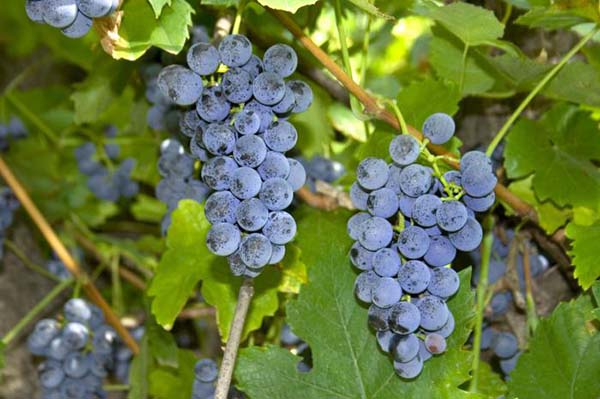
The fruits can be either oval or round, with a dense, firm skin. Isabella's flesh is slimy, with a pronounced strawberry aroma.
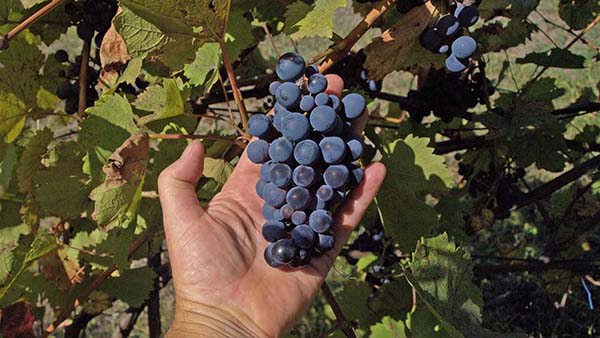
Suitable for both fresh consumption and for the preparation of ordinary wines.
Characteristics of the Isabella variety:
- ripening period - 150-180 days (late);
- sugar accumulation - 16-18%;
- acidity - 6-7 g / l;
- yield - 65-70 c / ha;
It prefers to grow on low-calcareous soils.
Advantages:
- The flowers are bisexual, which gives excellent self-pollination.
- Differs in high resistance against fungal diseases and phylloxera.
- It tolerates high humidity well.
By the way! Gives fruitful shoots from old wood and from replacement buds, which allows you to get a harvest even if the main (main) buds freeze.
Disadvantages:
- It does not tolerate drought very well (the growth force of the bush sharply decreases and leaves may fall).
Important! When the plantings are thickened, the grapes are affected by mildew.
Lydia (Isabella pink or red, Lydia pink)
It belongs to the isabel group.
It is characterized by a medium to strong growth rate.
Suitable for growing on a personal plot for gardening a gazebo. Also suitable for landscaping balconies, walls of houses.
Leaves can be of different sizes and shapes (three-, five-lobed), slightly dissected, there is a felt edge below.
The clusters are medium (120-200 grams), characterized by a conical or cylindro-conical shape, branching and a loose structure.

The berries are medium (about 2-3 grams), round, dark red, with a lilac wax bloom. The skin is firm, the flesh is slimy, there is a specific strawberry aroma.

Lydia responds well to fertilization and is not susceptible to waterlogging.
Characteristics of the Lydia variety:
- ripening period - 140-150 days;
- yield - 100-120 c / ha;
- sugar accumulation - 18-19%;
- acidity level - 5.5-9.3 g / l;
- frost resistance up to -29 degrees.
Important!The variety needs constant pinching and chasing, otherwise the plantings thicken strongly, which somewhat slows down the ripening of the fruits. However, in general, the Lydia variety is very unpretentious.
Benefits:
- Has bisexual flowers.
- Does not need treatment from mildew, oidium, because has field resistance against these diseases.
- One-year shoots ripen well.
- Drought tolerant.
- Delivers increased hydration.
- Relatively salt-resistant.
Disadvantages:
- Susceptible to calcareous chlorosis.
- Phyloxera resistance is insignificant.
- As the berries ripen, the stalks weaken.
It is often used for the preparation of dessert and strong wine materials, as well as juice.
Muscat of Hamburg (Muscat de Hamburg)
Obtained by crossing Frankenthal and Muscat of Alexandria. The variety was bred in England for greenhouse culture.
It is characterized by bushes of medium vigor.
The brush sizes reach 18-20 cm in length and 11-17 in width, conical in shape, branched, characterized by a loose structure. The weight of one bunch varies within 168-267 g. The stem of the bunch is of medium length (4-6 cm).
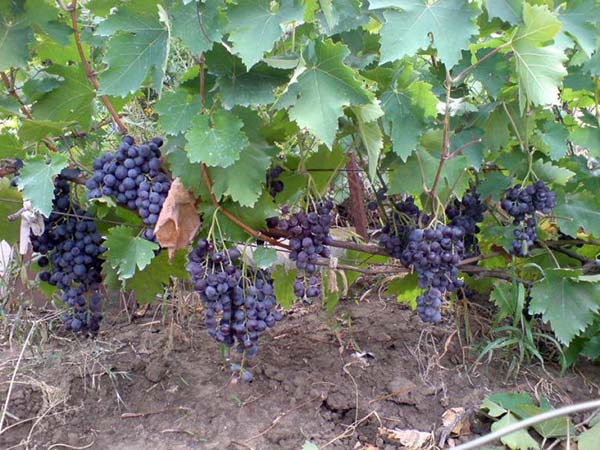
The berries are dark blue (violet-blue) with wax pollination. The fruits are round, less often oval, 12-26 mm long, 11-17 mm wide, 3-4 grams in weight. Their taste is pleasant, with a strong nutmeg flavor. Muscat of Hamburg has a juicy, fleshy pulp with a firm skin. There are 2-3 large seeds in the berry.

Compotes, juices, preserves and marinades made from berries of this variety are distinguished by their high taste.
Characteristics of the Muscat Hamburg variety:
- ripening period - 150 days;
- sugar accumulation 16-22%;
- acidity - 6-8 g / l;
- the ratio of fruitful shoots - 67%;
- bunch ratio - 1.58;
- frost resistance up to -18-19 degrees.
Note! This variety belongs to a group with potentially high, but very unstable yields.
Advantages:
- High tasting performance (9 points)
- The flowers are bisexual, which guarantees the ovary in any weather.
- It is almost not damaged by the grape leafworm.
- Wasps don't eat.
- It tolerates transportation well and can be stored for up to 2-3 months.
It grows well and bears fruit on the southern and southwestern slopes with light loamy, sandy loam and sandy soils.
Disadvantages:
- Very low frost resistance.
- Susceptible to almost all diseases, unstable to mildew, oidium, gray mold, bacterial cancer, phylloxera.
- Prone to peas.
- Annual shoots ripen satisfactorily, but with excess moisture and lack of heat, it is bad.
Every self-respecting winegrower and novice summer resident wants to grow a truly perfect grape variety. But a commonplace thing: there is not enough information. Now you have many options for choosing the most optimal varieties for your site. Good luck!
Note! if you have preference for the color of the skin and pulp of grapesthen you can read with separate detailed review articles about white, pink and black varieties.

